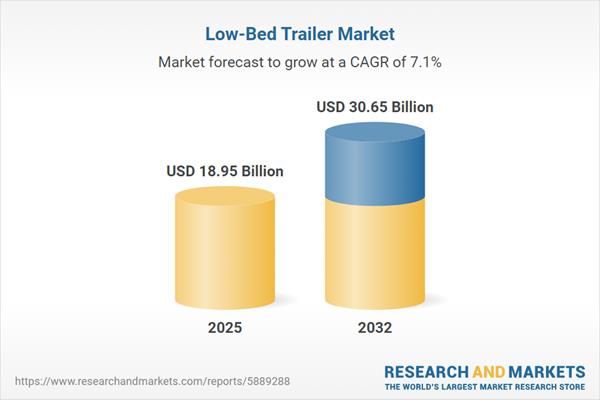Speak directly to the analyst to clarify any post sales queries you may have.
Senior decision-makers in logistics are navigating rising operational intricacies against a backdrop of shifting compliance standards and rapid technological change. The low-bed trailer market is playing a critical role in addressing these complexities, offering solutions that increase agility and reliability across global supply chains.
Market Snapshot: Low-Bed Trailer Market Growth and Trends
In 2024, the low-bed trailer market is valued at USD 17.66 billion, with projections reaching USD 18.95 billion by 2025 at a compound annual growth rate (CAGR) of 7.13%. By 2032, the sector is forecast to attain USD 30.65 billion, propelled by ongoing infrastructure investments and escalating demand for scalable, tailored logistics solutions. Procurement leaders are driving investments in modernization and product differentiation, with growing interest in innovative trailers to support high-demand sectors. Compliance with stricter safety standards is further accelerating the need for adaptable and reliable heavy-duty transport assets.
Scope & Segmentation of the Low-Bed Trailer Market
This comprehensive analysis delivers actionable segmentation insights essential for effective fleet modernization, procurement optimization, and risk-aware sourcing strategies in a competitive global landscape.
- Trailer Types: Hydraulic detachable, mechanical detachable, and standard formats offer versatility for diverse heavy equipment transport needs, supporting mission-critical logistics across projects.
- Load Capacities: Ranging from under 10 tons to over 80 tons, these segments serve both routine and complex project requirements, ensuring the right fit for varying operational scales and industry demands.
- Applications: Supported segments include construction, mining, oil and gas, and other resource-centric industries, enabling the seamless transfer of oversized and vital machinery for infrastructure and energy ventures.
- Axle Configurations: Single, tandem, tri, and multi-axle configurations increase adaptability to terrain and route requirements, streamlining both regional and cross-border operations.
- Sales Channels: Direct OEM distribution and robust aftermarket channels ensure continued fleet upgrades, reliable maintenance, and lifecycle management for diverse operator needs.
- Regions Covered: Analysis encompasses the Americas, Europe, Middle East and Africa, and Asia-Pacific, clarifying procurement and compliance landscapes across leading transport markets.
- Key Companies Profiled: Providers such as Faymonville S.A., Goldhofer Aktiengesellschaft, Nooteboom Trailers B.V., TII Group GmbH, Broshuis Trailerbouw B.V., CIMC Vehicles (Group) Co., Ltd., Kässbohrer Fahrzeugwerke GmbH, Talbert Manufacturing, Inc., Trail King Industries, Inc., and Fontaine Modification, Inc. are profiled to assist vendor evaluations and strategic partnership development.
Key Takeaways for Senior Decision-Makers
- Adopting advanced chassis designs and lightweight construction materials supports organizations in meeting sustainability targets and aligning with industry compliance requirements.
- Implementing digital fleet management and predictive maintenance technologies increases operational reliability and enhances equipment readiness across distributed locations.
- Utilization of telematics and flexible leasing or rental arrangements offers scalable asset control and improved project visibility for confident capital allocation.
- Building strong supplier networks mitigates procurement risks and ensures continual fleet access throughout critical operational cycles.
- Procurement focus is shifting toward sustainable components and harmonized specifications, enabling consistent compliance and more efficient total cost of ownership.
- Leveraging analytics and revised service models improves transparency, empowering leaders with robust oversight and enhanced risk management capabilities.
Tariff Impact: Navigating the 2025 United States Tariffs
Impending U.S. tariffs in 2025 present cost challenges for low-bed trailer inputs and critical components. Companies are strengthening supplier relationships, considering nearshoring, and intensifying collaboration throughout their supply chains to manage tariff-driven exposure. Enhancements in freight management practices and dynamic inventory strategies are emerging as essential tactics to ensure operational continuity alongside evolving regulatory requirements.
Methodology & Data Sources
This report combines interviews with logistics and transport executives, analysis of leading industry publications, and third-party validation from sector specialists. The methodology ensures comprehensive, reliable insights for procurement and investment planning in the low-bed trailer market.
Why This Report Matters for Strategic Decision-Makers
- Provides actionable intelligence by regional market and segment, supporting capital allocation and procurement decisions within the low-bed trailer market.
- Enables alignment of technology integration and growth initiatives with dynamic compliance and operational expectations.
- Equips executives with best practices for compliance, logistics efficiency, and risk control, driving confident leadership in procurement and asset management.
Conclusion
This analysis empowers senior decision-makers to adapt to changing market conditions, uncover new opportunities, and bolster operational resilience in the advancing low-bed trailer sector.
Additional Product Information:
- Purchase of this report includes 1 year online access with quarterly updates.
- This report can be updated on request. Please contact our Customer Experience team using the Ask a Question widget on our website.
Table of Contents
3. Executive Summary
4. Market Overview
7. Cumulative Impact of Artificial Intelligence 2025
Companies Mentioned
The companies profiled in this Low-Bed Trailer market report include:- Faymonville S.A.
- Goldhofer Aktiengesellschaft
- Nooteboom Trailers B.V.
- TII Group GmbH
- Broshuis Trailerbouw B.V.
- CIMC Vehicles (Group) Co., Ltd.
- Kässbohrer Fahrzeugwerke GmbH
- Talbert Manufacturing, Inc.
- Trail King Industries, Inc.
- Fontaine Modification, Inc.
Table Information
| Report Attribute | Details |
|---|---|
| No. of Pages | 199 |
| Published | November 2025 |
| Forecast Period | 2025 - 2032 |
| Estimated Market Value ( USD | $ 18.95 Billion |
| Forecasted Market Value ( USD | $ 30.65 Billion |
| Compound Annual Growth Rate | 7.1% |
| Regions Covered | Global |
| No. of Companies Mentioned | 11 |









